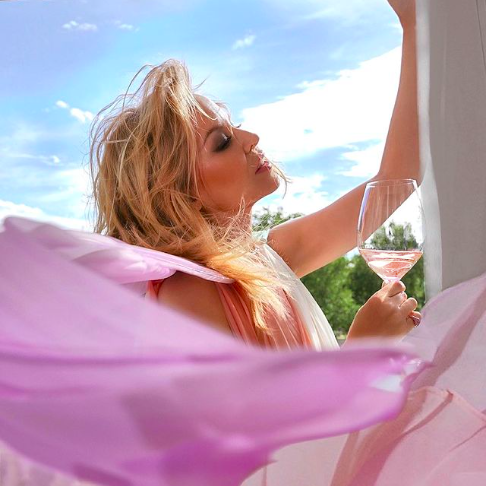As many countries in the Northern Hemisphere find their citizens largely vaccinated and liberated, the summer of 2021 is a very thirsty one. And a lot of eyes—and wallets—are turning once again to rosé.
In 2018, U.S. sales of pink wine were up 40 percent, and the growth continues at a breakneck pace. (The pretty blush comes courtesy of a process known as maceration; red grapes are pressed and left to soak with their skins for a day or two until the juice turns a subtle shade of pink.)
Pretty in Pink
There’s never been a better time to be shilling what some snobbish merchants describe as “swimming-pool wines,” or easy-drinking, pretty pink pours that read as good times on Instagram feeds.
“Rosé has become the Champagne of millennials,” anthropologist Richard Delerins declared at the 5th International Rosé Symposium (Rencontres Internationales du Rosé), in Marseille, in January 2019.
Accordingly, wine-makers and marketing-minded Hollywood types are scrambling to put their stamp on the trend. In 2008, Brad Pitt and Angelina Jolie (then happily coupled) were among the first to pull the cork on rosé when they bought Château Miraval, a 1,200-acre estate in France’s southern Côtes de Provence wine region.

Château Miraval was among the first brands to infuse its notes of red currants, fresh roses, and lemon zest with a hearty soupçon of old-fashioned American star power. The brand commissioned fashion photographer Lachlan Bailey to create a sultry video—starring Pitt—to sell the 2020 vintage. Following the scent of perfume marketing, the aesthetic presentation of the wine, which is bottled in slope-shouldered champagne-style bottles with deep dimples, is almost as important as the wine itself.
Pitt and Jolie aren’t the only ones who’ve gone into the rosé business. Working with esteemed French wine-maker Gérard Bertrand, rocker Jon Bon Jovi and his son Jesse Bongiovi created Hampton Water rosé to “capture the spirit shared between the Hamptons and the South of France.”
Produced in the Languedoc from a blend of Grenache, Cinsault, and Mourvèdre grapes, it’s been both a commercial and critical success, with a 90/100 rating from Wine Spectator, and it even has its own Instagram handle, with more than 65,000 followers.
In 2017, Star Wars creator George Lucas, who also owns Skywalker Vineyards, in California, bought Provence’s Château Margüi with the aim of producing connoisseur-quality rosés.

Just a 20-minute drive away is Domaine le Canadel, an exquisite wine-making estate in the Provençal town of Brignoles. George and Amal Clooney signed a contract to buy the property this spring, but another prospective buyer claims to have signed a contract to purchase the estate at a lower price, so the matter is currently tied up in court.
But the high-profile vintner isn’t exclusively a high-end affair. Working in collaboration with New Zealand winery Invivo, Sarah Jessica Parker launched SJP Rosé x Invivo, which retails for around $15 a bottle, and still manages to earn fairly respectable reviews.
Not one to miss out on the locomotion, Kylie Minogue debuted Wines by Kylie Minogue, a label created with Benchmark Drinks in London, in 2020, and among its offerings is a Côtes de Provence Rosé.
Taste Test!
For an expert’s insight, there’s no better authority than the renowned rosé expert Elizabeth Gabay, master of wine, who recently tasted more than a thousand 2020 vintage French rosé wines for the latest edition of her Buyer’s Guide to the Rosés of Southern France.
“Since 2007, the volume and quality of French rosé has been increasing,” says Gabay. “Among the reasons for this were the financial crash in 2008—rosé is cheaper than other wines but looks glam, and then there’s the wine’s popularity among Instagrammers, the fact that it sells quick and fast during the summer months, which is good for wine-makers’ cash flow, and cheaper rosés can be made with higher yields, no aging and leftover grapes.”

Gabay mentions several of her favorite rosés, including Rosé en DéCalage, Perrin Reserve Rosé, Secret of Pink, Grands Vins Littoral organic rosé (“The pink-flamingo label looks cheap and cheerful, but this is a seriously good wine,” she says), and Domaine de Valdition Alpilles Rosé 2020. “During the last three years, the quality of high-end French rosé has been steadily improving, too,” she adds.
Perfect examples of this flight to quality in French rosé are the ones that wine-maker Gérard Bertrand is making in the dramatic new cellar of his Clos du Temple estate, outside of Cabrières, a village in the Languedoc that claims to be the birthplace of rosé wines. Bertrand’s biodynamic 2018 Clos du Temple, a blend of grenache, Cinsault, Syrah, and Viognier, was named the world’s best rosé by the British trade magazine The Drinks Business.
While Hollywood and the Internet would like to claim the rosé boom as their own, they didn’t exactly invent the stuff: the Cabrières wines were a favorite quaff of King Louis XIV, who stocked them in his cellar at Versailles. Finally it can be said that long-dead royals and Internet-addicted influencers have at least something in common.
Alexander Lobrano is a Paris-based writer and restaurant critic. His latest book, the gastronomic coming-of-age story My Place at the Table, is out now


